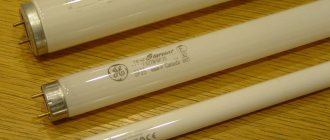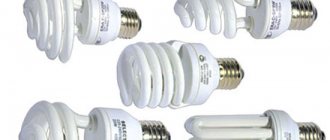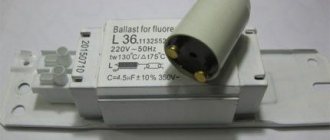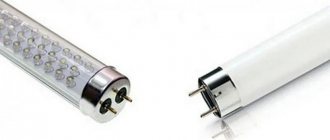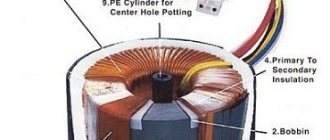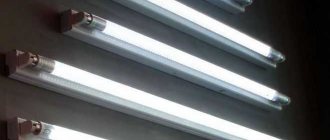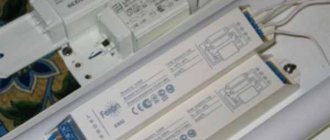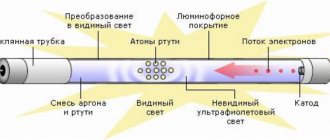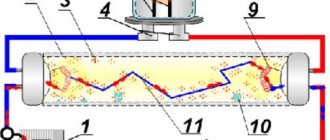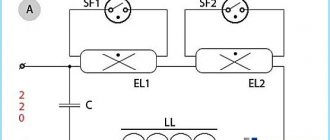Energy-saving fluorescent lamps require mandatory compliance with a number of conditions during operation. One of them is the recycling of fluorescent lamps. Many users do not comply with this requirement and throw faulty lamps into general waste containers. As a result of such actions, the mercury contained inside the glass case comes out and causes significant harm to the environment. Faulty fluorescent lamps must be handed over to specialized collection points.
Which lamps contain mercury?
Light output in mercury-containing lamps occurs due to fluorescence - a phenomenon in which mercury vapor under the influence of electrodes provokes the glow of the internal phosphor coating. Depending on the type of device, there are:
- arc mercury fluorescent lamps of high and low pressure (special and general purpose);
- arc metal halide;
- mirror metal halide;
- mercury-quartz;
- fluorescent lamps.
If the flask is damaged, at least 50% of mercury vapor immediately enters the air. Quantitatively, this figure can reach 2-3.5 mg. As a result, the permissible concentration in an unventilated room can exceed the standard values by 5-10 times.
What are mercury lamps?
Fluorescent lamps are lighting devices that provide comfortable, daylight-like light. It is this advantage that made them popular in the market. Such lamps are often installed in offices and shopping centers, commercial and industrial organizations. They are also used as home lighting. Compact fluorescent lamps (CFLs) have high light output, are 5 times more energy efficient and can last up to 15,000 hours.
Today, dangerous mercury-containing fluorescent lamps have been replaced by more economical and safe LED lamps. All over the world, people and enterprises are trying to use them in organizing lighting.
But, despite all these advantages, a huge disadvantage of lamps is the presence of mercury vapor. Their amount in different types of lighting devices ranges from 3 mg to 46 mg of hazardous metal in one lamp.
The mass of mercury in a device depends on its size and age. New lamps contain up to 3-4 mg and are sold as low-mercury. To maintain the light, only a few tenths of mg of mercury are needed; the rest is absorbed by the internal parts of the lamp, which maintains the glow of the arc.
What is the danger to humans and the environment?
Depressurization of mercury lamps leads to the creation of hazard class I situations. A very small amount of vapor can quickly contaminate an air space with a volume of 50-55 m³. As a result, damage is caused to the human immune, nervous and cardiovascular systems. Contact with toxic fumes may damage the skin, vision, and gastrointestinal tract.
With prolonged contact, mercury can accumulate both in the human body and in the environment. During the action of microorganisms, the metal enters the soil, and from it into groundwater. Contaminated land cannot be used in agriculture; it is not cleaned, but only disposed of by special enterprises.
Fluorescent lamp recycling process
There are several options for recycling mercury lamps. The thermal vacuum processing method is common in Russia. The procedure for recycling fluorescent lamps is as follows:
- Waste is collected, stored and stored in a container for recycling fluorescent lamps until recycled.
- The lamp is crushed by a press.
- The raw materials are sent to a high temperature chamber.
- The released gas enters a vacuum trap, where it is condensed and filtered.
There is a similar method in which the final stage of evaporation is exposed to liquid nitrogen. Mercury becomes solid, making it easy to collect.
Another disposal method is reagent. The lamps are crushed in a press, then treated with chemicals whose action is aimed at forming a poorly soluble compound upon contact with mercury.
Recycled waste produces a small amount of mercury, which is reused to make similar lamps. Crushed glass, which is used in the production of abrasive materials, is suitable for recycling. The phosphor separated during the procedure is subject to disposal at landfills.
Recycling equipment
Recycling of fluorescent lamps is carried out using special equipment designed to work with hazardous chemicals. These types of equipment include the Ekotrom-2 vibro-pneumatic installation and the URL-2-M demercurization installation, which are produced in Russia. Foreign equipment is also used for recycling fluorescent lamps, which is used at recycling plants in many countries around the world.
Storage conditions
At enterprises where fluorescent illuminators are used and stored, orders are issued aimed at creating safe operating conditions. The described requirements apply to both used and working lamps.
Must be stored in separate warehouses. There are containers in which the lamps are stored. The room should be well lit and ventilated using a ventilation system.
Mandatory storage conditions:
- The floor of the room is covered with waterproof material to prevent it from entering the ground in the event of a mercury leak.
- A large container of water and potassium permanganate are constantly stored in the room.
- Store in sorted order by size.
- A log is kept that reflects the number of used and operating lamps.
- Each lamp must be in a cardboard case to eliminate the risk of damage.
It is strictly forbidden to store lamps without packaging outside containers or containers. Do not lay them on the floor, open ground or place them in places where they can be easily damaged. The room in which hazardous material is stored must be isolated from company employees, and only those involved in lighting maintenance have access to it.
Rules and regulations
Modern rules and regulations for the disposal of fluorescent lamps are mandatory for all residents of the Russian Federation. The mechanism for handling devices of this type is regulated by Decree of the Government of the Russian Federation No. 681 of September 3, 2010, the requirements of SanPiN 2.1.7.1322-03 and Federal Law No. 89 “On production and consumption waste.”
Until this moment, such rules applied only to residents of the capital. Enterprises, as before, are required to enter into disposal agreements with companies specializing in this type of activity.
The requirements strictly prohibit throwing lamps into household trash, as a result of which the glass bulb is damaged and mercury vapor enters the airspace.
The territorial bodies of the SES and environmental inspectorates monitor compliance with legislation and SanPiN requirements. Failure to comply with their instructions may result in significant fines.
Should incandescent light bulbs be recycled?
How to dispose of incandescent lamps, do you need to do it in any special way? Previously widespread incandescent lamps are rapidly losing their positions. Such devices use tungsten filament and inert gases. This type of lighting device has low efficiency. However, it also has a significant advantage compared to devices containing mercury, namely, incandescent lamps do not pose a threat to the environment and do not require special recycling technology. Although the processing of this kind of waste makes it possible to obtain recyclable materials for various industries.
Where to donate light bulbs
Licensed enterprises have the right to remove and dispose of fluorescent lamps. However, citizens can hand over used devices to specialized collection points equipped with sealed containers, where distribution occurs according to the size and shape of the flask.
In the capital, you can hand over devices to the REU or regional DEZ, where, by order of the Moscow Government, they are required to accept them.
Important! Also, in large cities of Russia, you can hand over lamps to the housing office or management company, whose employees, according to the Instructions on organizing the collection and accumulation of waste, are required to keep a log of receipt and transfer. A number of IKEA stores have departments that accept different types of energy-saving light bulbs.
How much do professional services cost?
In most major cities of the country there are enterprises for the disposal and recycling of unusable fluorescent lamps. They have a special license that gives permission to dispose of various types of household waste. Their responsibilities include the removal, collection, actual disposal and disposal of mercury-containing lamps.
The cost of the service will depend on where the enterprise is located and on the type of lamp itself. Average prices across the country are as follows:
- for direct fluorescent lamps - 16 rubles/pcs;
- DRL (arc mercury phosphor) - 20 rubles/piece;
- solarium lamps - 35 rubles/pcs;
- broken mercury lamps - 400 rubles/kg;
Ecotron is one of the largest organizations in the country that deals with demercurization, recycling of solid household and industrial waste (solid household and industrial waste), purification of mercury, and, of course, recycling of lamps.
Main conclusions
There are several ways to recycle fluorescent lamps. However, they have one thing in common - neutralization and processing should be carried out only by enterprises with the appropriate license.
- Depressurization of a fluorescent lamp can cause significant damage to both human health and the environment.
- Disposal is regulated by the norms of the Law and the requirements of SanPiN.
- There are 4 main ways to dispose of mercury-containing devices.
- In large cities, reception is carried out in all housing offices, REUs and management companies; in settlements, if a problem arises, you can contact the administration, the Ministry of Emergency Situations, REUs or the power grid.
- You can also take luminescent devices to a store that sells devices of this type.
Recycling of energy-saving mercury lamps, both by enterprises and citizens of the Russian Federation, is a significant contribution to maintaining the environmental safety of the environment.
Previous
Lamps and luminairesHow to properly connect LED strip to the network
Next
Lamps and luminairesChoosing dimmable LED lamps
Fluorescent lamp recycling journal
The government decree obliges manufacturing and other enterprises to keep records of the use, replacement and recycling of mercury-containing light sources. With the help of such a document, compliance with established environmental standards is monitored, and records are kept for subsequent reporting during inspections.
The log is maintained by an authorized employee. Actual dates and information on the number of operated, replaced and disposed lamps are reflected. The journal is prepared in accordance with a standard form and must be filled out regularly. For the absence or incorrect execution of a reporting document, an enterprise may be fined, deprived of its license, or subject to other types of liability.
What is included in waste?
Each fluorescent lamp includes:
- 92% glass;
- 2% metal;
- 0.02% mercury;
- 5.9% phosphor.
Dispose of:
- luminescent;
- ultraviolet;
- mercury;
- energy saving;
- sodium light bulbs.
Recycling of mercury lamps is a procedure in which the recycled materials of a product are restored to a state in which the recycled material can be further used to produce new products. Special containers are used for storage; they are tightly closed with a lid.
Conditions
There are several options for recycling hazardous lighting fixtures, but not many are used. The most popular option.
- First, the recyclable lighting fixtures are combined.
- A special sealed container is used to collect their wounds.
- The “garbage” is placed in an oven, where it is heated to 400 degrees, at which temperature the hazardous metal transforms into a gaseous state. The resulting gas is removed through the hood.
You may be interested in Various staircase lighting systems
Conditions for disposal
Note! Catchers are installed on special hoods that disinfect the steam removed from the furnace.
It is important that all safety measures are observed during the work process.
General information
The demand for fluorescent light bulbs has increased sharply due to the active promotion of energy-saving lighting products and the federal law “On Energy Saving”.
Law “On Energy Saving”
The reason for the great threat to the environment was the poor awareness of citizens about the dangers of these lamps (such metal has the first class of danger). Recycling points for energy-saving lamps are poorly organized.
Disposal of mercury-containing lamps without proper safety controls can lead to contamination of air, soil and water with mercury compounds.
Security measures
Organizations and enterprises wishing to obtain a license to process such waste are required to have:
- Special facilities for the conservation and neutralization of hazardous components and components.
- Equipment and specialized installations for working with each component of the device.
- Specially equipped transport with appropriate markings.
- There must be trained employees with the necessary qualifications. Certificates of qualification are required.
Additional safety measures are internal mandatory rules of behavior and work at such an enterprise. Having personal protective equipment is a must. The enterprise must monitor the quality and condition of protective suits and work equipment in general.
Improper storage of lamps
Proper recycling of mercury-filled lamps is simply a necessary condition for their normal operation. A device of this type can be quite life-threatening if the garbage is not “thrown away” correctly. It is imperative to return the device for recycling, where all hazardous substances will be isolated.
What should those who live outside major cities do?
There are no collection points for mercury-containing light sources, so we have prepared a list of enterprises that can (and some are simply obliged) to help get rid of them even in rural areas .
In addition, we have prepared recommendations that will help you independently deliver such lamps to the nearest collection point if, for some reason, the responsible persons were unable or unwilling to help you.
Here is a list of enterprises whose employees are involved in the disposal of mercury-containing lamps, and therefore can help in this matter :
- Electrical networks.
- Village or district administration.
- REU or UK
- Ministry of Emergency Situations.
- Hardware or construction stores.
Electrical networks
Regardless of the size of the village or farm, electric lines are laid in it, which means there is an enterprise that must service them . In most cases, the enterprise serves several dozen or even hundreds of settlements occupying the territory of one or several districts.
It always includes a chief power engineer, who is in charge of fluorescent and, less commonly, mercury light sources. Therefore, it is necessary to contact him and ask him for help, because one of the responsibilities of an energy engineer is to control the disposal of such light sources.
Even if at some enterprise it is not the chief power engineer, but an ecologist or other specialist , then it will not be difficult to contact him.
This person has a connection with the company that recycles these lamps, so he may well be able to help get rid of them. Another question is whether he will want to help for free or will expect some kind of reward for his help.
Most likely, you will have to pay for the services of a company involved in the destruction of such light sources and, possibly, compensate the energy company for the cost of transporting the lamps to the disposal site.
Village or district administration
Local administration at any level must inform residents about the time and place of arrival of a special vehicle that will deliver the collected lamps to the processing plant.
If the local administration does not respond in any way to requests for help with the disposal of these items, it is necessary to contact a higher-level administration, but if this does not help, then complain to Rosprirodnadzor and the prosecutor's office .
REU or UK
In villages with multi-storey buildings, the following are required to dispose of mercury-containing lamps:
- management company (MC);
- repair and maintenance department (REU);
- another company that serves them.
This organization must have an agreement with the processing enterprise, so it is enough to come to the REU or Management Company and bring used or faulty light sources, the rest must be done by the employees and management of the organization.
Refusal to accept mercury-containing lamps is illegal, so you must immediately contact Rosprirodnadzor or the prosecutor's office of your area.
Ministry of Emergency Situations
The district department of the Ministry of Emergency Situations is another place where they can help with the disposal of mercury and fluorescent lamps.
Despite the fact that the Ministry of Emergency Situations workers are not involved in the destruction of such light sources, they have contacts with processing plants and the ability to safely deliver lamps to them.
Hardware and construction stores
Therefore, you can bring used light sources to the store.
However, be prepared for the fact that its owner will try to get rid of this burden . After all, all costs of delivery and disposal will fall on him.
How to transport lamps?
There is no need to take any special safety measures; each light source just needs to be wrapped in several layers of thick cloth or inserted into a cardboard package . After this, all dangerous objects must be placed so that they do not fall during movement and sent to the nearest collection and disposal point.
On the road, avoid sudden acceleration and braking, as well as any maneuvers involving rapid changes in speed or body roll.
These instructions apply only to individuals who decide to independently deliver mercury-containing light sources to a recycling facility.
For enterprises licensed to transport and dispose of this waste, the requirements are completely different.
Therefore, if you want to equip a receiving point in your locality, then you will need to not only obtain all the necessary licenses and permits, but also install a special container in which the lamps will be located during storage and transportation.
INSTRUCTIONS FOR HANDLING WASTE 1 HAZARD CLASS
General provisions
This Instruction determines the procedure for handling waste of hazard class 1 “Mercury lamps, mercury-quartz, fluorescent, which have lost their consumer properties.” The instructions have been developed in accordance with the following legislative and regulatory acts of the Russian Federation:
- Law of the Russian Federation of January 10, 2002 No. 7-FZ “On Environmental Protection”;
- Law of the Russian Federation dated June 24, 1998 No. 89-FZ “On production and consumption waste”;
- Law of the Russian Federation of March 30, 1999 No. 52-FZ “On the sanitary and epidemiological welfare of the population”;
- Decree of the Government of the Russian Federation dated September 3, 2010. No. 681 “On approval of the Rules for the management of production and consumption waste in terms of lighting devices, electric lamps, improper collection, accumulation, use, neutralization, transportation and disposal of which may cause harm to life, health of citizens, harm to animals, plants and the environment” ;
- Order of the Ministry of Natural Resources of the Russian Federation No. 445 dated July 18, 2014 “On approval of the Federal Classification Catalog of Waste”;
- Order of the Ministry of Natural Resources of the Russian Federation dated June 15, 2001. No. 511 “On approval of the Criteria for classifying hazardous waste as a hazard class for the natural environment”;
- SanPiN 2.1.7.1322-03 “Hygienic requirements for the disposal and disposal of production and consumption waste.”
General information about waste
2.1. Mercury, mercury-quartz, fluorescent lamps (hereinafter referred to as mercury-containing lamps) are gas-discharge light sources, the principle of which is as follows: under the influence of an electric field in mercury vapor pumped into a sealed glass tube, an electrical discharge occurs, accompanied by ultraviolet radiation.
2.2. A phosphor applied to the inner surface converts ultraviolet radiation into visible light.
2.3. In accordance with the Order of the Ministry of Natural Resources of the Russian Federation dated July 18, 2014 No. 445 “On approval of the Federal Classification Catalog of Wastes,” the waste “Mercury lamps, mercury-quartz, luminescent, which have lost their consumer properties” has code 47110101521 and belongs to waste of hazard class 1 - extremely hazardous waste.
2.4. The degree of harmful impact of hazard class 1 waste on the environment is very high. When they impact the environment, the ecological system is irreversibly disrupted. There is no recovery period.
2.5. The physical state of waste is a finished product that has lost its consumer properties.
2.6. Hazardous properties of waste - toxicity.
Component composition of waste in accordance with its passport:
- silicon dioxide - 70.5%;
- mercury - 2.0%;
- metal - 27.5%.
2.7. Uncontrolled handling of failed mercury-containing products (lamps, thermometers, instruments, etc.) leads to contamination of the environment (industrial, office, public and residential premises) with mercury or its vapors to concentrations that pose a direct threat to human health.
Terms and Definitions
3.1. Waste mercury-containing lamps - mercury-containing waste, which represents lighting devices and electric lamps with mercury filling and a mercury content of at least 0.01 percent that are decommissioned and subject to disposal.
3.2. Consumers of mercury-containing lamps are legal entities or individual entrepreneurs who do not have a license to carry out activities for the collection, use, neutralization, transportation, and disposal of waste of I-IV hazard classes.
3.3. Accumulation is the storage by consumers of mercury-containing lamps, with the exception of individuals, of the amount of waste mercury-containing lamps permitted in accordance with the established procedure.
3.4. Specialized organizations are legal entities and individual entrepreneurs that collect, use, neutralize, transport and dispose of waste mercury-containing lamps and have licenses to carry out activities for the collection, use, neutralization, transportation, and disposal of waste of I-IV hazard classes.
3.5. The breaking of a mercury-containing lamp is an emergency. Under no circumstances is it recommended to store broken mercury lamps in the same container with whole used lamps. For broken lamps, a report is drawn up, it indicates the type of broken lamps, their quantity, and an entry is made in the register of used mercury-containing lamps.
3.6. An emergency is a situation in a certain territory that has arisen as a result of an accident, a dangerous natural phenomenon, a catastrophe, a natural or other disaster that may result or has resulted in human casualties, damage to human health or the environment, significant material losses and disruption of people’s living conditions.
3.7. An emergency zone is a territory where an emergency situation has occurred.
3.8. Elimination of an emergency situation - rescue and other urgent work carried out in the event of an emergency situation and aimed at saving lives and preserving the health of people, reducing the amount of damage to the environment and material losses, as well as localizing the emergency zone, stopping the action of the dangers characteristic of it factors.
3.9. Waste demercurization is the neutralization of waste, which consists in extracting the mercury or its compounds contained in them.
3.10. Demercurization of premises - neutralization of premises (their surface or volume) contaminated with metallic mercury, its vapors or salts. 3.11. Demercurizers are substances that interact chemically with metallic mercury or its compounds, resulting in the formation of stable and low-toxic compounds.
Hazardous properties of waste components
4.1. A hazardous component of the waste “Mercury lamps, mercury-quartz lamps, fluorescent lamps that have lost their consumer properties” (hereinafter referred to as spent mercury-containing lamps) is mercury, which has a toxic effect on humans and the environment. This substance is in lamps in a state capable of active air, water and physicochemical migration.
4.2. Mercury has a negative effect on the human nervous system, causing emotional instability, increased fatigue, memory loss, and sleep disturbances. Pain in the extremities (mercury polyneuritis) is usually observed. In addition, mercury has a toxic effect on the endocrine glands, the visual analyzer, the cardiovascular system, and the digestive organs.
4.3. With the mechanical destruction of one mercury lamp containing 20 mg of mercury vapor, 5000 m3 of air becomes unsuitable for breathing. Even in concentrations hundreds and thousands of times higher than the maximum permissible concentration, mercury vapor has no color, taste or smell, does not have an immediate irritating effect on the respiratory system, vision, skin, mucous membranes, etc., their presence in the air can be detected only with the help of special equipment. For this reason, personnel working in mercury-poisoned areas are unaware of it for a long time, even when symptoms of chronic mercury poisoning appear, often until signs of serious poisoning become obvious or pronounced.
4.4. Depending on the amount of mercury entering the body, acute and chronic poisoning are distinguished. Acute poisoning by mercury vapor occurs when it quickly enters the body in significant quantities. Chronic poisoning occurs with prolonged contact with small concentrations of mercury vapor. Acute mercury vapor poisoning occurs several hours after the onset of poisoning. Symptoms of acute poisoning: general weakness, lack of appetite, headache, pain when swallowing, metallic taste in the mouth, salivation, swelling and bleeding of the gums, nausea and vomiting. Often there is pneumonia, catarrh of the upper respiratory tract, chest pain, cough and shortness of breath, often severe chills. Body temperature rises to 38-40°C. In the most severe cases, the victim dies within a few days.
4.5. Chronic mercury poisoning (mercurialism) leads to disruption of the nervous system and is characterized by the presence of asthenovegetative syndrome with distinct mercury tremor (trembling of the hands, tongue, eyelids, even legs and the whole body), unstable pulse, tachycardia, excited state, mental disorders, gingivitis. Apathy, emotional instability (mercurial neurasthenia), headaches, dizziness, insomnia develop, a state of increased mental excitability occurs (mercurial erethism), and memory is impaired.
4.6. Inhalation of mercury vapor with strong exposure is accompanied by symptoms of acute bronchitis, bronchiolitis and pneumonia. Many symptoms of mercury vapor poisoning disappear when exposure is stopped and appropriate measures are taken, but complete elimination of mental disorders is impossible.
4.7. The noted syndromes and symptoms are observed when exposed to mercury vapor at concentrations in the air of more than 0.1 mg/m3. But mental disorders can also occur at lower concentrations.
4.8. Micromercurialism develops with prolonged exposure to low concentrations of mercury vapor in the air - no more than hundredths of mg/m3. It manifests itself depending on the body and the state of the nervous system. Typically, its manifestations are initially expressed in decreased performance, fatigue, and increased excitability. Then these phenomena intensify, memory impairment occurs, anxiety and self-doubt, irritability and headaches appear.
4.9. Diagnosing mercury poisoning is very difficult. They are hidden under the guise of diseases of the respiratory system or nervous system.
Waste generation and collection
5.1. Persons at least 18 years of age who have undergone training labor protection are allowed to work on the replacement and collection of used mercury-containing lamps .
5.2. Personnel working with waste mercury-containing lamps must have a complete understanding of the effect of mercury and its compounds on the human body and the environment.
5.3. Trained and instructed employees bear full responsibility for violation of the requirements of this instruction in accordance with current legislation.
5.4. Sources of waste “Mercury lamps, mercury-quartz lamps, fluorescent lamps that have lost their consumer properties” are ceiling and table lamps used for lighting industrial and domestic premises.
5.5. A prerequisite for replacement, temporary storage, transportation of used mercury-containing lamps, as well as transportation, storage and installation of new mercury-containing lamps is to maintain their integrity and tightness.
5.6. In order to prevent accidental mechanical destruction of mercury-containing lamps, they should be handled with great care.
5.7. Any actions (throwing, hitting, disassembling, etc.) that could lead to mechanical destruction of mercury-containing lamps, as well as storing used or defective mercury-containing lamps in containers with solid household waste are prohibited.
5.8. After removing a used mercury-containing lamp from a luminaire, each used mercury-containing lamp must be packaged in individual factory containers made of corrugated cardboard.
5.9. In the absence of individual corrugated cardboard packaging, each used mercury-containing lamp of any type (brand) must be carefully packaged (wrapped) in paper or thin soft cardboard, protecting the lamps from mutual contact and accidental mechanical damage.
5.10. Used mercury-containing lamps packed in corrugated cardboard or paper are transferred to a temporary accumulation site, where their performance is immediately checked. After the lamps are confirmed to be inoperable, they are recognized as waste, carefully packaged again and moved to a temporary storage area.
5.11. New mercury-containing lamps for replacement in lamps are issued only after the transfer of used mercury-containing lamps to the temporary accumulation site. Mechanical destruction of mercury-containing lamps as a result of careless handling is an emergency situation in which emergency measures are taken in accordance with Section 9 of these instructions. Parts of broken lamps and the room in which they were broken must be subjected to demercurization.
Conditions for temporary storage and accumulation of waste
6.1. Temporary accumulation of used mercury-containing lamps is permitted for no more than 11 months in a storage area specially designated for this purpose in a room located separately from production and domestic premises.
6.2. The room must be well ventilated, protected from chemically aggressive substances, precipitation, surface and ground water.
6.3. Warehouse doors must be securely locked and marked “No Trespassing.” It is mandatory to have a plate with the details of the person responsible for the accumulation of waste in the warehouse, for example, “Responsible for the warehouse – full name”.
6.4. Storage of used mercury-containing lamps should be carried out in undamaged containers from new mercury-containing lamps or in other containers that ensure their safety during storage, handling and transportation.
6.5. At the waste accumulation site there must be an inscription or a sign “Waste of hazard class 1. Waste mercury-containing lamps."
Prohibited:
- use of aluminum as a structural material;
- temporary storage and accumulation of used mercury-containing lamps in any industrial or domestic premises where enterprise personnel may work, rest or be present;
- storing and eating food, smoking in places where waste mercury-containing lamps are temporarily accumulated.
6.6. During the collection process, lamps are sorted by diameter and length, neatly and tightly packed into containers, boxes or crates (shipping containers). There should be a separate container, box or box for each type of lamp. It is mandatory to check the correctness and integrity of the internal packaging of the lamps, and correct defects if necessary.
6.7. The maximum weight of cardboard and plywood containers when filled should not exceed 15 kg, metal containers - 30 kg.
6.8. In order to ensure the necessary strength and tightness of the packaging, cardboard boxes must be covered with adhesive tape at least 50 mm wide along all seams, including vertical ones. The ends of the adhesive tape must extend to the walls of the cardboard box adjacent to the sealed seam by at least 50 mm.
6.9. Handling signs “Caution! Fragile! “Top”, on the cardboard boxes there is additionally a sign “Keep away from moisture”, and also a label (or inscription) of any size is pasted on it, which indicates the type (brand) of lamps, their length, diameter and the number of lamps packed in this box. Stickers with these inscriptions are allowed. It is prohibited to place other types of cargo on containers (boxes, crates) with lamps.
6.10. In a container (box, crate) filled with used mercury-containing lamps (protected by internal packaging), voids and free movement of lamps are not allowed. When filling a container, the gaps between adjacent lamps, as well as between the lamps and the walls of the container, are sealed with means of shock absorption and fastening (paper, newspapers, plastic film, etc., except for shavings).
6.11. The top of the cardboard box is closed, the last seam is sealed with adhesive tape. The metal box is locked.
6.12. As waste accumulates to the established norm (but not more than 6 months), used mercury-containing lamps are transferred for demercurization to a specialized enterprise in accordance with the concluded agreement.
6.13. If there are insufficient spent mercury-containing lamps to fill the container (box, drawer), all voids are tightly filled with the above soft shock-absorbing agents.
Prohibited:
- accumulation of used mercury-containing lamps in places of temporary accumulation in excess of the established standard;
- storage of used mercury-containing lamps in places of temporary accumulation for more than 6 months.
6.14. Due to the fact that broken mercury-containing lamps contaminate the external surfaces of undamaged lamps, personnel clothing and places of temporary accumulation of used mercury-containing lamps, their joint storage and packaging in the same containers with intact lamps is not allowed.
6.15. Parts of broken mercury-containing lamps are accepted at the temporary waste accumulation site only packed in durable sealed containers (strong sealed plastic bags).
6.16. Mercury collected during a spill is taken to the temporary waste accumulation site only in tightly closed thick-walled glass jars, packed in sealed plastic bags.
6.17. Devices, materials, special clothing, and personal protective equipment used during demercurization work are accepted at the temporary storage site placed in a durable sealed container or in a bag containing a demercurization kit.
6.18. Parts of broken mercury-containing lamps packed in plastic bags, mercury in a tightly closed glass jar, a bag with materials and devices used during demercurization work are tightly placed in a sealed container made of impact-resistant material, sealed with shock-absorbing means and secured in a transport container. The impact-resistant container is locked.
6.19. Storage of broken mercury-containing lamps, collected mercury, materials and devices used during demercurization work at a temporary waste accumulation site is permitted for no more than 5 working days, during which they must be transferred for demercurization to a specialized enterprise.
Prohibited:
- storage in a temporary storage warehouse of broken waste mercury-containing lamps or mercury without sealed containers;
- storage of broken used mercury-containing lamps or mercury in impact-resistant sealed containers in a temporary waste storage warehouse for more than 5 working days.
Accounting for waste generation and movement
7.1. Accounting for the formation and movement of spent mercury-containing lamps is kept in a journal, where the generation of waste is obligatorily noted and its transfer to a specialized enterprise for demercurization. The pages of the magazine should be numbered and laced.
7.2. When transferring used mercury-containing lamps from a temporary waste storage warehouse to a specialized enterprise for demercurization, a record of the transfer of waste must be made in the logbook for recording the formation and movement of used mercury-containing lamps, indicating the date of transfer.
7.3. The original of the act (certificate) of acceptance and transfer of used mercury-containing lamps is transferred to the accounting department, a copy of it is necessarily transferred to the chemical engineer of the enterprise.
Transfer of waste to specialized enterprises
8.1. The transfer of used mercury-containing lamps for neutralization (demercurization) is carried out in accordance with an agreement concluded with a specialized enterprise licensed to collect, use, neutralize, and transport hazardous waste.
Prohibited:
- destruction, disposal into a container with solid household waste or transfer of used mercury-containing lamps subject to demercurization to individuals or legal entities that do not have a license to collect, use, neutralize, transport, dispose of hazardous waste;
- placement of spent mercury-containing lamps in landfills and solid waste dumps.
8.2. Before loading used mercury-containing lamps into a vehicle, check the correctness, integrity and compliance of their transport packaging with the requirements listed in Section 6 of these instructions. If necessary, correct deficiencies, and only then begin loading work.
8.3. When loading waste mercury-containing lamps, it is necessary to take into account meteorological conditions:
- It is prohibited to load waste mercury-containing lamps during rain or thunderstorms;
- When there is ice, loading areas should be sprinkled with sand.
8.4. Work on loading waste mercury-containing lamps must be carried out in the presence of a responsible person.
8.5. Crowds of people are not allowed in areas designated for loading waste mercury-containing lamps.
Prohibited:
- throw, hit, turn over packages (boxes, crates) with waste mercury-containing lamps upside down or on their sides;
- damage in any way the transport containers in which waste mercury-containing lamps are packaged;
- place other types of cargo on packages (boxes, crates) containing waste mercury-containing lamps;
- smoke when loading waste mercury-containing lamps.
Measures to eliminate emergency (emergency) situations
9.1. When handling used mercury-containing lamps, an emergency (emergency) situation is understood as the mechanical destruction of mercury-containing lamps without spillage or with spillage of mercury.
9.2. The content of emergency response measures depends on the degree of mercury contamination in the premises. It is mandatory to call specialists from the emergency rescue service of the Ministry of Emergency Situations of Russia by calling “01” (“112” - cellular operators) in case of mechanical destruction of mercury-containing lamps.
9.3. If there is mechanical destruction of no more than 1 mercury-containing lamp and the enterprise has a demercurization kit/kit for eliminating the consequences of an emergency, it is possible to carry out preparatory work to demercurize the premises and eliminate the emergency.
Prohibited:
- carry out work to eliminate the consequences of an emergency situation in the event of mechanical destruction of a mercury-containing lamp by the enterprise personnel in the absence of a demercurization kit/kit.
9.4. Persons at least 18 years of age who have undergone a medical examination, have no medical contraindications and are familiar with the instructions for working with the demercurization kit are allowed to carry out demercurization work. They must be provided with special clothing, personal protective equipment for the respiratory system, legs, hands and eyes in accordance with clause 15.3 of the Sanitary Rules when working with mercury, its compounds and devices with mercury filling dated 04.04.88 No. 4607-88.
9.5. The demercurization kit/kit includes all materials and equipment necessary for demercurization work:
- personal protective equipment (respirator, gloves, shoe covers);
- devices for collecting spilled mercury and parts of broken lamps (syringe, copper and hair brushes, wet wipes, tray, scoop);
- chemical demercurizers, detergent, etc.
9.6. All of the above is packed in a special bag (25x30cm).
9.7. The use of a demercurization kit makes it possible to reliably eliminate small mercury contaminations (8-10 maximum permissible concentrations) arising from a single mechanical destruction of a fluorescent lamp or medical thermometer. The demercurization kit must be kept by the person responsible for the environmental activities of the organization (or the person replacing him).
Elimination of the consequences of an emergency situation in the event of mechanical destruction of no more than 1 mercury-containing lamp
10.1. Elimination of the consequences of an emergency situation in the event of mechanical destruction of one mercury-containing lamp and minimal spillage of mercury (no more than the amount contained in one medical thermometer) consists of carrying out two sequential measures:
- localization of the source of infection;
- eliminating the source of infection.
10.2. The goal of the first activity is to prevent further spread of mercury pollution, and the result of the second activity is to minimize the damage from the emergency.
10.3. Localization of the source of contamination is carried out by limiting the entry of people into the contamination zone, which helps prevent the movement of mercury to clean areas of the room, while it is necessary:
- remove personnel from the premises as quickly as possible;
- turn off all electrical appliances, if possible, reduce the room temperature to at least 15°C (the lower the temperature, the less mercury evaporates);
- close the door to the room, leaving the window open, carefully seal the door to the room with adhesive tape;
- intensively ventilate the room for 1.5-2 hours;
- After this, you can lightly close the windows and begin to eliminate the source of infection.
10.4. Elimination of the source of infection is carried out using a demercurization kit/kit and involves the following procedures:
- mechanical collection of lamp fragments and/or spilled metallic mercury;
- demercurization itself - treating the premises with chemically active substances or their solutions (demercurizers);
- wet cleaning.
Prohibited:
- presence at a mercury-contaminated facility of persons not associated with the performance of demercurization work and not provided with personal protective equipment;
- at a mercury-contaminated site, eat, drink, smoke, unfasten and remove personal protective equipment;
- drink alcohol before and during demercurization work;
10.5. Before starting to eliminate the source of infection, it is necessary to open the demercurization kit/kit and carefully study the instructions for carrying out demercurization with its help.
10.6. Put on personal protective equipment (working clothes, safety shoes, shoe covers, respirator, protective gloves, goggles) and only then begin to collect fragments of a broken mercury-containing lamp, spilled mercury and demercurization of the room.
10.7. Collection of fragments of a broken mercury-containing lamp or spilled mercury is carried out using the devices included in the demercurization kit (syringe, copper and hair brushes, wet wipes, tray, scoop) from the periphery of the contaminated area to its center.
10.8. It is unacceptable to limit yourself to inspecting only visible and accessible areas.
Prohibited:
- create a draft before the spilled mercury has been collected, otherwise mercury balls will scatter throughout the room;
- sweep up spilled mercury with a broom: hard rods will crush the balls into fine mercury dust, which will scatter throughout the entire room;
- collect mercury using a household vacuum cleaner: the vacuum cleaner heats up and increases the evaporation of mercury, air passes through the vacuum cleaner engine and a mercury amalgam is formed on the engine parts, after which the vacuum cleaner itself becomes a distributor of mercury vapor, it will have to be disposed of as a waste of hazard class 1, subject to demercurization.
10.9. The easiest way to collect mercury is with a syringe. Very small (dust-like) droplets of mercury (up to 0.5-1 mm) can be collected with damp filter paper or newsprint (wet wipes). The paper is soaked in water to a significant degree of loosening, wrung out and in this form used for wiping contaminated surfaces. Droplets of mercury adhere to the paper and are transferred with it to an airtight container for collecting mercury.
Prohibited:
- throw parts of a broken mercury-containing lamp into a container with solid household waste;
- throw mercury down the drain, as it tends to settle in sewer pipes and is incredibly difficult to remove from the sewer system;
- keep collected mercury near heating devices.
10.10. The collected small fragments of a mercury-containing lamp and/or mercury are transferred to a tightly sealed container made of unbreakable glass or thick-walled glassware, previously filled with an acidified solution of potassium permanganate.
10.11. To prepare 1 liter of solution, add 1 g of potassium permanganate and 5 ml of 36% acid to the water (included in the demercurization kit). Large parts of a broken mercury-containing lamp are collected in strong, sealed plastic bags.
10.12. Through a thorough inspection, make sure that the fragments have been collected completely, including taking into account the presence of cracks in the floor.
10.13. Parts of broken mercury-containing lamps and/or collected mercury in a tightly closed glass container, packed in sealed plastic bags, are transferred to a temporary waste storage warehouse, where they are placed in sealed impact-resistant containers, sealed with shock-absorbing means and secured in transport containers. Within 5 working days they must be transferred for demercurization to a specialized enterprise.
10.14. Chemical demercurization of a room contaminated with mercury is carried out by specialists of the emergency rescue service of the Ministry of Emergency Situations of Russia or employees of specialized organizations with appropriate training, personal protective equipment, equipment and chemicals for demercurization of objects.
10.15. After completing the work, all used equipment and materials, special clothing, and personal protective equipment must be collected and placed in a bag containing a demercurization kit and transferred to a temporary waste storage warehouse, where they are placed in sealed impact-resistant containers, sealed with shock-absorbing means and secured in a transport container. Within 5 working days they must be transferred for demercurization to a specialized enterprise.
10.16. Wet cleaning is carried out at the final stage of demercurization work. All surfaces are washed with a soap-soda solution heated to 70-80°C (400g soap, 500g soda ash per 10l of water) with a consumption rate of 0.5-1 l/m2. Instead of soap, it is allowed to use technical 0.3-1% aqueous solutions of detergents and household washing powders. Cleaning is completed by thoroughly washing all surfaces with clean tap water and wiping them dry with a rag, and the room is ventilated.
10.17. An accredited laboratory conducts analytical studies of the presence of residual mercury vapor and the effectiveness of work to demercurize the contaminated premises.
Elimination of the consequences of an emergency situation in the event of mechanical destruction of more than 1 mercury-containing lamp and/or spillage of mercury
11.1. In case of mechanical destruction of a mercury-containing lamp, you must:
- remove personnel from the premises as quickly as possible;
- turn off all electrical appliances, if possible, reduce the temperature in the room to at least 15°C (the lower the temperature, the less mercury evaporates), close the door to the room, leaving the window open, carefully seal the door to the room with adhesive tape;
- notify the director of the enterprise (the person replacing him) responsible for environmental protection of the organization;
- report the emergency situation to the operational duty officer of the emergency rescue service of the Ministry of Emergency Situations of Russia by phone 01 and call specialists to eliminate the consequences of the emergency, since without the appropriate equipment you cannot be sure of removing mercury contamination;
- Based on the results of an instrumental examination of a room contaminated with mercury, emergency rescue service specialists determine the technology of work, the type of demercurization drugs, and the required frequency of treatment of the room;
- liquidation of the consequences of an emergency (emergency) situation, demercurization of the premises and further actions - in accordance with the instructions of emergency rescue service specialists.
DOWNLOAD: Instrukciya-po-obrashcheniyu-s-othodami-1-klassa
Similar articles:
- Instructions for handling batteries Instructions for handling waste of hazard class 2. Lead acid batteries...
- Instructions for use of cylinders PRODUCTION INSTRUCTIONS FOR OPERATION, STORAGE AND TRANSPORTATION OF CYLINDERS INTENDED FOR COMPRESSED, LIQUEFIED AND DISSOLVED GASES UNDER PRESSURE 1. Characteristics of equipment 1.1. Cylinders designed for…
- Instructions on fire safety measures in baths (saunas) Instructions on fire safety measures in baths (saunas) Basic fire safety requirements Possibility of placing dry heat baths in buildings for various purposes…
Actions to take if the integrity of the lamp is damaged
If it turns out that the lamp is broken or damaged, then:
- provide ventilation on site;
- carefully collect large fragments;
- small fragments should be collected with adhesive tape, napkins, towels and under no circumstances should a vacuum cleaner be used;
- Clean using products containing bleach.
Bleach will help clean the room
Do not throw away residue or flush it down the drain. Pack them in a cardboard box and take them to a point that accepts lamps.
Recycling locations
Citizens who want to comply with all the rules regarding the correct “disposal” of faulty dangerous lighting devices often ask themselves the question: where do they accept lamps for recycling?
Where to throw away light bulbs
There are several options:
- According to the law, such lighting devices are required to be accepted in housing offices and REUs.
- There are also private companies that collect burnt out or broken equipment. Usually they display special containers in public places - stores. An excellent option is the IKEA hypermarket. These stores have special containers.
- Separate tanks are located in individual cities in the building maintenance and repair departments. These organizations must accept damaged fluorescent lamps.
- The devices can be rented to industrial enterprises involved in the maintenance of electrical networks and lighting. Typically, companies cooperate with companies that process toxic household waste.
Not all cities have such facilities, so you can use a courier service. Here they accept burnt out or broken fluorescent devices. Then they ask themselves where to dispose of fluorescent lamps, selecting a specialized organization.

